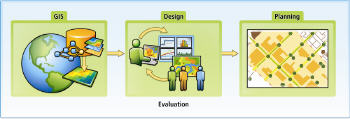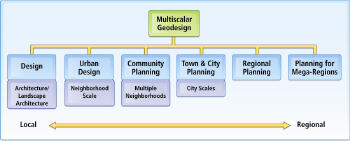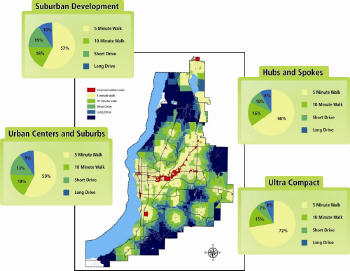GeoDesign is an emerging term for a technique that combines design and GIS technology to create cutting edge tools for urban planning, architecture, design and community development. This article describes how GeoDesign is reinvigorating Smart Growth plans and planning processes.
Why Smart Growth needs to be smarter
Smart Growth is called "smart" because it seeks to strike an intelligent balance between unfettered sprawl and restrictive no-growth policies. Despite drawbacks, its principles of compact development, reduced automobile dependence, mixed uses, reduced resource consumption and increased emphasis on sense of community are widely admired. (Smart Growth detractors point, for example, to potential problems with population density and congestion, social equity, affordability and continuing consumer demand for conventional subdivisions.) But to move successfully from these academic principles to on-the-ground implementation requires a great deal of work.
One of the biggest hurdles is in understanding how to apply Smart Growth principles in a local context. For example, the mix of uses that is best for a growing city full of young professionals will be very different from the mix of uses needed for an area whose youth are migrating elsewhere and whose remaining population is aging.
Another significant hurdle is the conventional planning process.
 |
At its best, Smart Growth seeks to balance a wide spectrum of needs that cover the economic, environmental and social systems operating in a community. That broad net means that planners, elected officials, the public and experts from many fields need to work together toward mutual understanding. But the conventional comprehensive planning and zoning process, which is mostly linear, expert-dominated and rigid, discourages needed collaboration and public engagement.
Smart Growth becomes smarter when innovative techniques and new technologies are used to help develop more context-sensitive plans and support a more flexible, collaborative planning process. An increasingly powerful part of this help comes from tools for GeoDesign.
GeoDesign for smart growth
Most planners are already using GIS at some level. At the least, their future land use maps are made with GIS tools, and their parcel data are stored in GIS databases. This type of use does not take advantage of full GIS capabilities. GeoDesign combines the information capacity of GIS with the decision making process of design, yielding tools that are informative, interactive and ideal for Smart Growth plans and planning processes.
While GeoDesign is still a loosely defined term, it includes at least four elements:
- Sketching is the concept of drawing potential designs or plans, usually with approximate parameters and few details. It does not need to be limited to lines and colors; it can include any data changes like putting numbers in tables, changing building heights, or turning on a new power plant. Some planners have always done sketching naturally in their heads; GeoDesign allows them to demonstrate and communicate their ideas even at the earliest stages of invention. With GeoDesign, sketching is often public. It provides a collaborative brainstorming environment.
- Spatially informed models estimate how various systems (environmental, economic, etc.) will respond to the plans suggested by the sketches. These models provide information on both impacts (like costs or water consumption) and change (like population growth rates or development patterns).
- Fast feedback gives near-immediate results from modeling the effects of a sketch. This means that a GeoDesign tool can support collaboration or a brainstorming session.
- Iteration is a hallmark of GeoDesign. You sketch an idea, find out its implications, make adjustments and try again, often many times within a single work session. The freedom to try many alternatives has advantages besides simple speed. For example, it encourages creativity, helps teams work together, and increases understanding of the complex systems that Smart Growth planning addresses.
 |
GeoDesign is an art form because it incorporates elements of sketching and design. It is a science because it incorporates elements of modeling and analysis. In light of this, the functional definition of GeoDesign for Smart Growth is the art and science of geospatially enabled sketching and modeling. GeoDesign enhances collaboration, scenario generation, monitoring of implications, ongoing feedback, and evaluation and selection of optimal designs that reflect a community's needs and visions for the future.
Some planners are accustomed to the idea of scenario planning, in which potential alternative futures are modeled and measured as a way of making decisions about present-day actions. GeoDesign and scenario planning are closely related; their differences are mostly semantic. The simplest distinction is that GeoDesign allows real-time changes in the plan, while scenario planning relies more on comparing a few premade alternatives. Many tools that support scenario planning also support GeoDesign, and vice versa.
Collaborative/Participatory GeoDesign
Historically, planning has been done by experts on behalf of the communities they serve. Public reviews of plans have been seen as inconvenient procedural requirements with mostly symbolic value. But a new paradigm replaces planning for people with planning with people. Residents are experts, too, in their own way; they know more than anyone about the history, values and culture of where they live, and they have a deep understanding of how the informal systems of the community work. Instead of parachuting planners into specific communities and expecting them to come up with smart solutions without a frame of reference about the history of the place or the local planning culture, we need to listen to and engage the real experts (the people who live there and know what works and what does not). Smarter Smart Growth considers these factors alongside conventional planning needs, and GeoDesign helps make it possible for the public to engage in the process and contribute in meaningful ways.
Multiscalar GeoDesign
 |
Planners tend to think of design at a site scale, but GeoDesign covers a variety of scales, bridging the gap between the regional and the local contexts. This is important, because to be practically effective and politically prudent, Smart Growth plans need to make sense across a spectrum of scales and disciplines. This ranges from design, urban design, community planning, town and city planning, and regional planning, up to planning for mega-regions.
Technology for GeoDesign
GeoDesign is a new term for a technology that already has strong roots. ArcGIS itself has always had basic GeoDesign abilities, but with the release of ArcGIS 10, GeoDesign has become a centerpiece of the application. One of the best established GeoDesign tools for planners is CommunityViz, an ArcGIS Desktop extension designed expressly for scenario planning.
GeoDesign Project Planning Example
Kelowna, British Columbia is a growing Canadian city of a little over 100,000 residents. In 2009, the city set out to update its Official Community Plan (OCP), which is like an American comprehensive plan. It placed strong emphasis on analyzing sustainability measures that are similar to Smart Growth principles, and retained Urban Systems, Ltd. and Placeways, LLC to support the process with ArcGIS and CommunityViz software.
Sketching - A central part of the effort was sketching and analyzing potential future land use maps. Using CommunityViz, the project team created maps representing four contrasting development scenarios that ranged from suburban development to ultra compact. As they created each map, they were able to sketch small and large variations on the basic theme of the scenario. (In this case, the sketching was done via table input for added precision. They could also have used more conventional hand drawings on the map.)
Spatially informed models - CommunityViz provided a platform for setting up a wide variety of spatially-informed impact models that measured the sustainability effects of the sketched plans. One part of the analysis, for example, calculated the number of households that would be within walking distance of commercial services. Another looked at the area of open space and agricultural lands consumed, while still others monitored the mix of land uses.
Fast feedback - Data regarding impacts were displayed in several forms, including map symbology, dynamically updated charts, and Excel spreadsheets that had been electronically linked to CommunityViz.
Iteration - The plans went through several rounds of review that included small team meetings among planners, large public sessions, and more formal reviews with the city council. At many stages along the way, the sketched plans were tweaked and adjusted. However, the CommunityViz analysis did not need to change, because its models were set up to update automatically and produce new feedback on the basis on the new sketches.
 |
This project demonstrated the successful use of GeoDesign technology to help the public and elected officials make informed policy decisions during a comprehensive planning process. Using ArcGIS and CommunityViz to analyze, visualize and communicate ideas helped make the project a success.
GeoDesign benefits
GeoDesign can make Smart Growth smarter by improving both Smart Growth plans and the Smart Growth planning process.
The plans are better because they are based on more accurate, complete information. GeoDesign provides information about a plan's implications very early in the planning process, while plans still exist only as sketches and ideas. GeoDesign does not necessarily replace the more thorough, careful analysis that needs to follow as policies are written, budgets are drafted, and service capacities are engineered. Yet it does help ensure that the initial plan sets the smartest direction possible.
The process is better because it is more transparent and inclusive. The inclusiveness comes from GeoDesign's ability to engage broad audiences who would otherwise lack the means by which to contribute. The transparency comes from the way GeoDesign makes information and trade-offs explicit: everyone can see how this sketch leads to that result.
GeoDesign technology has been available for several years. With rapid increases in computer processing power and the release of ArcGIS 10, the tools are advancing even more rapidly.
The bottom line is that GeoDesign offers an opportunity for fresh improvements to old approaches for implementing Smart Growth and making Smart Growth smarter.
Ed. note: Readers may also find this podcast of interest: A Hallway Conversation with Ken Snyder, President and CEO, PlaceMatters